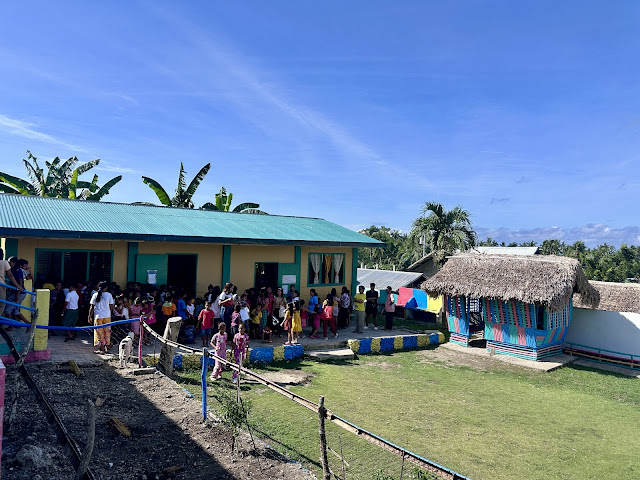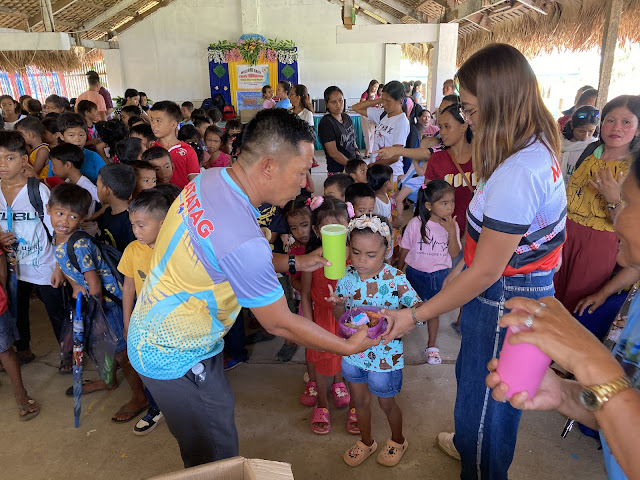Before the pandemic, we made a promise to a small community in Burias Island that we would return. They had just endured a typhoon that nearly wiped everything out. None of us could have imagined that an even greater storm was still to come.
I never let go of that promise, but the pandemic hit us hard as a group. Costs continued to rise, priorities shifted, and everything began to take more time and energy than it used to.
About a year ago, I received a message from Sir Rodel, the new principal of Malacbalac Elementary School. He said the community still remembered TRails to Empower Kids (TREK), our group, and hoped we could visit again.
When the timing finally felt right, I traveled back to San Vicente, a remote community on Burias Island in Masbate under the municipality of Claveria. I was with Benjie, our volunteer, chief cook, and everyone’s favorite uncle.
It felt like coming home. After more than five years, they still remembered our faces. They welcomed us along the trail with joy and warmth.
The sight of the school moved us. What was once reduced to rubble now stood proud and solid. In 2019, we had left behind more than just construction materials. We left behind hopes quietly tucked into nails, wood, and roofing sheets. As the pandemic came and time stretched on, we often wondered if they had been able to rebuild. So when we saw the school standing, beautiful and complete, we were in awe.
The community had also made progress. They now have a cemented trail, electricity in the evenings, and piso wifi that helps them connect with the rest of the world.
I could not wait to share all of this with the rest of our volunteers.
When we got back to Manila, we quickly mobilized to help the children welcome the new school year with the supplies they needed. In a community as remote as San Vicente, access to even the most basic school essentials is a challenge. With no nearby stores and limited transportation, families often have to make do with whatever is available.
Donations started pouring in. Volunteers began signing up. And we started preparing for the mission.
But it was not without challenges. Just days before our scheduled outreach, a low pressure area threatened the country. Some volunteers began to panic and started cancelling, including one of our dentists. I thought we might have to cancel the dental mission, even though everything was already prepared.
To reach the community, we needed to travel at least four hours by boat, so the weather was a major concern. I considered postponing, but with the rainy season in full swing, I knew our window to visit the island would only get smaller.
I asked for prayers from everyone and kept checking with our volunteers from PAGASA for updates.
When I went ahead with Uncle Benjie two days before the rest of the team, I was still unsure if it would push through. We traveled early because we had decided to source most of the donations from Pio Duran to save on transport costs.
But thank God, seventeen volunteers decided to push through.
From Pio Duran, we took a rented boat. We had to rush because the waves were expected to pick up in the afternoon. It was cloudy during our four-hour sail. I stayed on the roof of the passenger area, enjoyed the wind, and prayed the entire way.
Even after nearly eighteen years, the fear, anxiety, and stress never seem to fade.
We were told that we might have to dock at a different location if the waves were too high, which would mean a longer trek to the school. But as long as we arrived safely, that was all that mattered.
Thank God the waves were manageable. Soon, we were docking, unloading donations, and walking to the school. The clouds kept the trail cool.
When we arrived, a generous lunch spread was waiting for us. I told them how thankful we were that we reached the school safely and that the weather had been kind. One of them smiled and said, isang barangay ang nagdadasal. An entire community had been praying. It was deeply humbling, and it reminded me once again why we do what we do.
After having our late lunch, we rested a bit, then started repacking. Our lone dentist, Dr. Jing, began seeing patients. Uncle got things rolling in his kitchen, and the rest of us handled the donation packs.
That night, I slept in my new hammock after a few drinks with our volunteers. I woke up early because I did not want the kids to see me still asleep.
Then, like clockwork, we carried out the day’s activities. While the kitchen was bustling and our makeshift dental clinic was in full swing, we kicked off the program by distributing morning snacks.
After that, the kids started fitting their new shoes and slippers. I was not good at estimating sizes, so some of the older kids did not get the right pairs. We left a budget with the principal to buy shoes for them.
We then distributed hygiene kits, backpacks, and envelopes. We also turned over televisions, computers, and a net to cover the school’s roofing.
The kids had their lunch after the distribution of their new school supplies, using their new mess kits. They were served spaghetti and fried chicken. The school officials brought out lechon, their way of welcoming and thanking us, and we all shared the meal together. After lunch, we all enjoyed mango ice cream.
We left after and headed to San Isidro, a nearby barangay, for our side trip. We always make time to spend a day or two with our volunteers to unwind, exchange stories, and reflect on the experience.
We stayed at Les Coquillages, and it was the best resort for us. It was quiet, not just because there were no other guests and no blaring videoke, but because the space itself invited calm. There were no bright flags or loud designs, just wide open areas of white sand and simple villas. It felt like a place made for exhaling. Only our laughter echoed across the resort.
We ate well. That morning, we walked along the beach to look for fresh catch, so we had seafood on our table. We also brought lechon to celebrate the birthdays of our volunteers: Frankie, who has been with TREK since day one, Uncle Benjie, and the father of Dr. Jing. We also asked some of the local kids to gather uni, or tuyom, for us.
Our stay was slow and sweet. We went swimming, shared meals, told stories, and watched the sunset. On our second day, I took another long walk as the light faded, reaching the far end of the beach. San Isidro stretches beautifully, with a shoreline that runs about eight kilometers.
It was four fulfilling days of giving back. Six for me. And even with the exhaustion and all the nerves that came before it, I would do it all again in a heartbeat.









































































